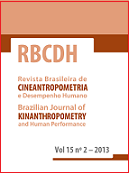Built environment score related to leisure-time physical activity: application in a region of low socioeconomic status
DOI:
https://doi.org/10.1590/1980-0037.2013v15n2p243Abstract
There is little evidence on the relationship between leisure-time physical activity (LTPA) and built environment in Brazil, especially in areas of low socioeconomic status. The objective of this study was to describe indicators of built environment score related to LTPA for adults living in a region of low socioeconomic status. We conducted a cross-sectional study of 767 adults living in Ermelino Matarazzo district in São Paulo, 2007. The dependent variable was the practice of LTPA (in minutes per week). Independent variables were 35 environment variables that were evaluated by an audit instrument in 30 census tracts. LTPA was correlated (Spearman coefficient) with all environment variables, and variables that had p<0.20 were selected to compose two scores (variables with p<0.05 had weight value of 2): Infrastructure (score 1) and Safety for commuting (score 2). Both scores were divided in quintiles and the built environment was composed by the sum of the quintiles of these scores, ranging from 2 to 10 points. Quartiles of built environment were calculated and the first was considered as the most adequate environment for LTPA. The built environment score had 14 variables significantly associated with LTPA and were considered as important attributes for this leisure practice.



